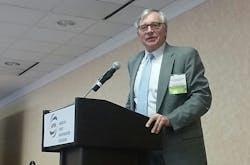Partnerships between universities and The Rapid in Grand Rapids, Michigan, are creating significant economic and sustainable impacts in the region.
At the American Public Transportation Association’s Public Transportation & Universities Conference in Grand Rapids, Michigan, university professionals, planners and transit professionals came together to share best practices and to discuss the challenges of serving the university communities.
Peter Varga, chief executive officer of The Rapid and James Bachmeier, vice president for Finance and Administration at Grand Valley State University and former Grand Rapids Mayor George Heartwell kicked off the conference sharing highlights of how the partnership has played a transformative role in Grand Rapids.
When talking about Grand Rapid’s past, he said they moved from “strategic planning” to doing “sustainability planning” and today, that partnership has more than 260 members from the business sector, healthcare sector, non-profits, higher education, all working together on sustainability planning.
Grand Valley State University looked for the biggest cornfield for its primary campus, he said, which was about 12 miles west of downtown. At the time it was a modest college and today it’s a sprawling campus with 26,000 students with an economic impact on the region of about $800 million annually.
Initially there was no transit service to the campus, so there were a whole lot of cars and parking. The university went to The Rapid and asked for help. For a year there was a pilot program for a shuttle service and it was wildly successful.
Lisa Haynes, assistant vice president, Pew Campus & Regional Centers, Grand Valley State University, said they started with one bus an hour. Today they have 6 minute headways at peak times.
With the continued growth of ridership, Haynes said they have not had to build additional parking since 2004, an ever-growing concern for many universities. Many higher education institutions are looking to be more sustainable and a critical consideration is how students, faculty and staff are getting to and around campus.
Today The Rapid provides three million rides to students that are shuttling back and forth, not parking in parking lots, not clogging the roads.
Jennifer Kalczuk, external relations manager for The Rapid said, “The Rapid and Grand Valley wanted to build a transit culture on campus. We want students to know, this is what you do; you hop on the bus and get to campus or downtown.”
The university expanded and opened a building in Grand Rapids with no student parking. The community already had parking challenges, so the building was designed with a bus lane built into the building. Students would be able to easily ride the bus from campus to the entry of this building.
To get the message out to students, they used a direct mail campaign and orientations riding the bus with them as the building was being built. “It was a lot of hand holding, but it was successful,” said Haynes.
Due to the growth, they are planning on upgrading the Route 50 Campus Connector service to a bus rapid transit (BRT) line, which has been included in the President’s budget for 2017.
Varga talked about the success of The Rapid's first BRT line, the Silver Line, which the future Laker Line will be modeled after. “The Silver Line operates as efficiently as light rail at one-tenth the cost,” he said.
To increase capacity and sustainability, the Laker Line will run articulated CNG buses.
Other higher education institutions saw the success of GVSU and modeled it, Heartwell said. And, he added, “These services run without millage support; the universities are paying their fair share.”
Not only are they reducing traffic congestion and easing parking issues today, he said this is developing a generation of transit users.
Heartwell stressed, “If your university and city isn’t working together, there is probably a mayor that needs to wake up because it’s a powerful tool to be able to use.
“Transit will play an increasingly important role in the growth and development of cities all over this country,” he said. “Congestion equal air quality diminishment, societal stress and health issues. Anything that we can do to reduce congestion is going to contribute to a better quality of life for our people.”



